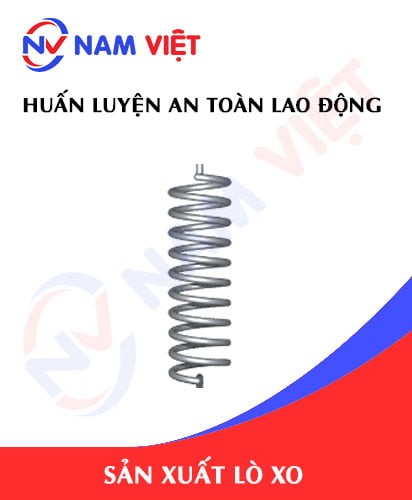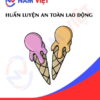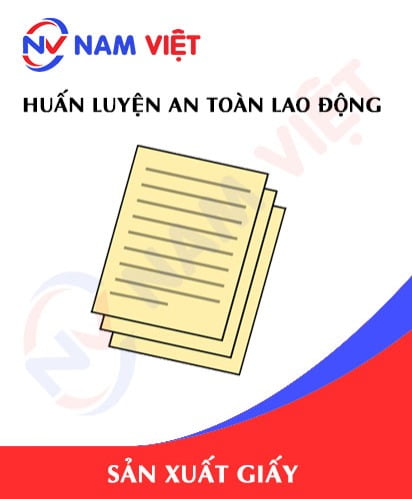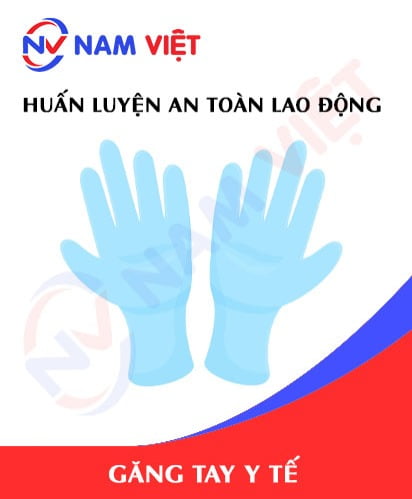Occupational Safety Training in Spring Manufacturing Factory
99,000 ₫
Note: The above price is calculated for one person, the price may fluctuate depending on the number of trainees participating in the course and the movement of the market. For more accurate pricing support, please refer to the quotation table or contact our consulting staff directly.
Occupational safety is an important issue in spring manufacturing factories and needs to be addressed promptly to ensure the health and safety of workers and enhance the reputation of enterprises. The Occupational Safety Training course is one of the effective solutions to raise awareness about preventing occupational accidents for workers when participating in spring manufacturing.
Table of Contents
Toggle1. Overview of springs
a. What is a spring?
- A spring is a mechanical component created by bending or twisting a metal wire into a specific shape. The spring can maintain its shape when compressed or stretched and can return to its original shape when the load is removed.
- Springs are commonly used in various applications, including electronic devices, industrial machinery, automobiles, furniture, beds, and other household products. Common types of springs include compression springs, extension springs, torsion springs, and flat springs.
- The properties of a spring, including stiffness, compression, elasticity, and durability, can be adjusted by changing the size, diameter, number, and spacing of the spring’s coils, as well as the material and manufacturing process.
- The types of springs manufactured in Vietnam include metal springs, stainless steel springs, and rubber springs. Among them, metal springs are the most popular product used in many industries, including automotive, electronics, refrigeration, furniture, construction materials, and sports.
- Some of the leading companies in the spring manufacturing industry in Vietnam are Viet Thang, Quang Minh, Thep Mien Nam, Thep Viet Nhat, Long Hung, Nam Kim, etc. These companies all meet product quality and safety standards and are building cooperative relationships with foreign partners.

b. Types of spring manufacturing machinery
To manufacture springs, businesses often use the following types of machinery and equipment:
- Spring coiling machine: This is a type of machine used to coil springs from steel wire or metal wire.
- Spring cutting machine: This machine is used to cut spring parts to the correct length.
- Spring bending machine: This machine is used to bend springs into the required shape and size.
- Spring polishing machine: This machine is used to polish and clean spring parts before they are put into manufacturing or sold.
- Spring testing equipment: These are devices used to check the quality and accuracy of spring parts.
In addition, spring manufacturing businesses also use other equipment and technologies such as cutting machines, punching machines, and CNC machining machines to manufacture spring parts with high accuracy and meet customer needs.

c. Typical spring manufacturing enterprises in Vietnam
Below are some typical spring manufacturing enterprises in Vietnam:
- Viet Nhat Steel Production and Trading Co., Ltd. (VINASINO) – is one of the leading spring manufacturers in Vietnam with a large output and high-quality products.
- Quang Minh Spring Production and Trading Co., Ltd. – established in 1990, has long-standing experience in spring manufacturing, supplying products to major brands such as LG, Samsung, Panasonic, etc.
- Kim Thanh Metal Spring Co., Ltd. – was established in 1995, specializing in manufacturing various types of metal springs, stainless steel springs, round springs, square springs, triangular springs, etc.
- Nam Kim Spring Production and Trading Co., Ltd. – is one of the leading companies in the metal spring manufacturing industry in Vietnam, with products exported to many different markets around the world.
- Thai Hung Spring Co., Ltd. – specializes in manufacturing metal springs, stainless steel springs, elastic springs, jump springs, etc. The company’s products are used in many industries such as automotive, electronics, refrigeration, furniture, etc.
- Long Hung Spring Production and Trading Co., Ltd. – is one of the leading metal spring manufacturing companies in Vietnam with modern manufacturing processes and a team of experienced employees.
d. Specific jobs in a spring manufacturing factory
Group 1
- General director, deputy general director, department head in a spring manufacturing factory.
Group 2
- Safety officer: manages safety in the factory, designs safety procedures, supervises and urges employees to comply with safe working procedures.
Group 3
- Raw material preparation: Raw materials such as steel wire or metal wire will be prepared for spring manufacturing. These materials need to be checked for quality before use.
- Spring coiling and cutting: Metal or steel wires will be coiled into the required spring parts, then cut into different lengths.
- Spring bending: The spring parts will be bent into the correct shape and size required.
- Spring polishing and painting: Spring parts will be polished to remove scratches and cleaned before painting.
- Quality inspection: Spring parts will be checked for quality to ensure accuracy and meet quality standards.
- Packaging and shipping: Spring parts will be packaged and prepared for shipping to customers or put into storage for sale.
Group 4
- Office work, service, sales, marketing.
- Production management, quality management, human resource management, material management, financial accounting management.
- Production planning: Engineers and technical staff will plan manufacturing, including selecting materials and product technical specifications, scheduling production and quality control.

2. Overview of the occupational safety training course for spring manufacturing
Within the scope of this article, we focus on issues related to group 3, because group 3 is the group directly involved in the manufacturing process, bearing the highest risk of occupational safety. See more about the other groups here
a. What is group 3 occupational safety training?
- Group 3 occupational safety training consists of sessions that equip workers with awareness of how to prevent occupational accidents.
- The occupational safety training course will help workers recognize and prevent dangers, and limit the risk of occupational accidents during work.
REGISTER FOR OCCUPATIONAL SAFETY TRAINING SERVICE
b. Training duration
Initial safety training duration
- The total training duration is at least 24 hours, including the examination time.
- 8 hours of theoretical study on the system of policies and laws on occupational safety and health
- 8 hours of theoretical study on basic knowledge of occupational safety and health
- 4 hours of theoretical study on specialized training content
- 2 hours of practical study on specialized training content
- 2 hours of theoretical examination at the end of the training course
The safety training center will distribute the time into many training sessions depending on the time arrangement for employees. But usually, there will be 6 training sessions, and the course will take place for 3 days, provided that the manufacturing company can arrange continuous study time.
Periodic safety training duration
- Before the occupational safety card expires, if workers want to have it re-issued, they must undergo a periodic occupational safety training course, with the periodic safety training duration being at least 50% of the initial safety training duration.
Explanation: The total periodic occupational safety training duration is at least 12 hours, including the examination time. After completing the periodic training course and passing the examination, workers will have their occupational safety card re-issued or renewed.
c. Content of the training course
| No. | TRAINING CONTENT | TRAINING DURATION (HOURS) | |||
| Total | Of which | ||||
| Theory | Practice | Examination | |||
| I | System of policies and laws on occupational safety and health | 8 | 8 | 0 | 0 |
| 1 | Overview of the system of legal documents on occupational safety and health. | 6 | 6 | ||
| 2 | System of technical standards and regulations on occupational safety and health. | 1 | 1 | ||
| 3 | Specific regulations of state management agencies on occupational safety and health when building, expanding or renovating works, facilities for manufacturing, using, preserving, storing and inspecting types of machinery, equipment, materials, and substances with strict requirements on occupational safety and health. | 1 | 1 | ||
| II | Basic knowledge of occupational safety and health | 8 | 8 | 0 | 0 |
| 1 | Basic knowledge of dangerous and harmful factors at the workplace. | 4 | 4 | ||
| 2 | Methods to improve working conditions. | 1 | 1 | ||
| 3 | Safety culture in manufacturing and business. | 1 | 1 | ||
| 4 | Rights and obligations of employers, employees; policies and regimes on occupational safety and health for employees; functions and duties of the occupational safety and health network. | 1 | 1 | ||
| 5 | Occupational safety and health regulations, signs, safety and health signs and use of safety equipment, personal protective equipment; professional skills, first aid for occupational accidents, prevention of occupational diseases. | 1 | 1 | ||
| III | Specialized training content | 6 | 4 | 2 | 0 |
| General knowledge about types of machinery, equipment, and substances that generate dangerous and harmful factors; analysis, assessment, and management of occupational safety and health risks, safe working procedures with machinery, equipment, and substances with strict requirements on occupational safety and health. | 6 | 4 | 2 | ||
| IV | Examination of occupational safety training content at the end of the course | 2 | 2 | 0 | 0 |
| Total | 24 | 22 | 2 | ||
See more training content of the 6 groups
d. Occupational safety card
After completing the occupational safety training course and passing the examination, workers will be issued an occupational safety card (in practice often called a Group 3 occupational safety certificate).
The Group 3 safety card will clearly show information such as: full name, date of birth, specific job and working environment. It also includes the training duration, red stamp, and signature confirming completion of the training course.
According to the regulations on issuing safety cards specified in clause 2 of Article 24 of Decree 44/2016/ND-CP, there are two cases:
- If there is an employment contract between the employer and the employee, the employer must sign, stamp, and seal the safety card for the trained person in Group 3 after they have gone through the training course from the occupational safety training unit and passed the examination.
- If the worker is a freelance or seasonal worker and does not have an employment contract, the training unit must sign, stamp, and seal the safety card for the worker after they have gone through the training course from the occupational safety training unit and passed the examination.

3. Identifying hazards affecting workers when manufacturing springs
When manufacturing springs, workers may face some of the following hazards:
- Spring manufacturing factories often use electrical machinery, chemicals, and toxic gases that can cause fire and explosion hazards if not operated and stored properly.
- Handling metal and steel can cause injuries from impact or cutting, especially when workers do not wear proper protection.
- Chemical products used in the manufacturing process can cause pollution and affect the health of employees, especially if they do not wear full protective gear.
- Machinery and equipment in a spring manufacturing factory can cause danger if not used correctly or regularly maintained.
- Machinery in a spring manufacturing factory can generate high and prolonged noise, causing a risk of hearing damage to employees if they do not wear proper hearing protection.
4. Common types of occupational accidents for workers when manufacturing springs
Some common types of occupational accidents for workers when manufacturing springs include:
- Cutting and injury accidents from using sharp tools, spring manufacturing machinery, or metal materials.
- Fall and slip accidents due to slippery factory floors or surfaces made slippery by grease and other lubricants.
- Collision and impact accidents from moving materials or machinery and equipment in the factory.
- Chemical and pollution accidents due to employees not wearing full protective gear or being exposed to harmful chemicals.
- Fire and explosion accidents due to the use of unsafe machinery and equipment or improper chemical storage.
- Accidents related to the impact of noise causing hearing damage or toxic pressure on health.

5. Safety measures when participating in spring manufacturing
To ensure safety when participating in spring manufacturing, employees need to implement the following safety measures:
- Wear full protective gear, including helmets, safety glasses, masks, gloves, safety shoes, toxic gas absorbers, ear protectors, protective uniforms, etc.
- Ensure the work area is clean and tidy, and avoid placing unnecessary items in dangerous locations.
- Ensure correct use of machinery and equipment and comply with safe working procedures.
- Periodically check safety equipment such as machine guards, safety harnesses, and gas pipelines.
- Avoid contact with toxic chemicals and always use the correct protective substances when necessary.
- Comply with fire and explosion safety regulations, especially regarding chemical storage.
- Be trained in safety skills and procedures, such as emergency response in case of an occupational accident.
- Implement noise reduction measures such as using hearing protection devices and safe installation of machinery and equipment.
- Avoid overworking, working in a state of fatigue, drinking alcohol, or using stimulants.
- Undergo periodic health checks and ensure good health to participate in spring manufacturing.
- Periodically organize work environment monitoring in factories and enterprises, collect and analyze harmful factors for workers, thereby adjusting and reducing the level of harm to prevent occupational diseases for them.
6. Benefits of occupational safety training for spring manufacturing
An Toan Nam Viet provides your business with great benefits after completing the occupational safety training courses as regulated in Decree 44/2016/ND-CP on occupational safety and health work, for companies, enterprises.
- Employees can recognize the potential risks of occupational accidents and take preventive measures to avoid occupational accidents.
- Your business can establish risk prevention measures in the manufacturing, operation, and maintenance process.
- Minimize costs when there is a risk of occupational safety loss.
- An uninterrupted manufacturing process will help increase labor productivity and product quality.
- Comply with occupational safety laws, avoiding legal risks.
- Create credibility and professionalism in all aspects, thereby enhancing your business’s brand.
Nam Viet’s training courses are the solution to prevent and combat external factors affecting each individual so that they can avoid dangers that can lead to injury or, more seriously, death.
REGISTER FOR OCCUPATIONAL SAFETY TRAINING SERVICE
7. Customer feedback after completing the occupational safety training course for spring manufacturing
An Toan Nam Viet has many years of experience in the mission of accompanying many businesses in Vietnam in general and in the southern provinces in particular. And that responsibility to Nam Viet is something extremely valuable, which is why Nam Viet’s Occupational Safety Training work is increasingly focused on becoming more professional. The motivation for An Toan Nam Viet to grow strongly to this day comes from the positive feedback and suggestions from businesses. Below is the feedback from our partners that we have served.
Bac Nam E&C Investment and Construction Joint Stock Company
“The first time I used the service at An Toan Nam Viet, I was very surprised by the enthusiastic 24/7 support of the consulting team. The class organization was very quick and convenient for our company, thank you very much for Nam Viet’s service!”
Hoa Dat Construction and Trading Joint Stock Company
“Nam Viet’s service has helped us a lot in simplifying occupational safety and completing safety records for the work process. The consulting team is enthusiastic and timely with our questions. 5 stars for Nam Viet”
See more customer interviews after using An Toan Nam Viet’s service
8. An Toan Nam Viet’s Occupational Safety Training Capability
An Toan Nam Viet is a reputable and quality occupational safety training center in Vietnam today. With continuous occupational safety training sessions held at manufacturing workshops, factories or construction sites across the country (63 provinces and cities in Vietnam).
REGISTER FOR OCCUPATIONAL SAFETY TRAINING SERVICE
Occupational safety training license
- An Toan Nam Viet has been inspected by the Department of Labor Safety of the Ministry of Labor – Invalids and Social Affairs and granted a certificate of eligibility to operate occupational safety and health training. This further strengthens our occupational safety training capability.

Documents and lectures
- Before the occupational safety training documents are put into the occupational safety training courses, they have been reviewed and censored to ensure that the lectures are always correct in terms of knowledge and effective when applied.
- The teaching method of the lecturers is synchronized according to An Toan Nam Viet’s teaching standards, which is a method that experts on occupational safety and health training have researched and drawn from the teaching process to bring the highest knowledge acquisition efficiency to students.
Facilities
- The control of factors in the classroom affecting the training process will increase the teaching performance and the knowledge acquisition efficiency of the students.
- The facilities supporting our training course always arrange spacious classrooms that meet the standards for area, lighting, training equipment, etc.
9. Reputable and quality safety training center nationwide
At An Toan Nam Viet, we always put the professional dedication to occupational safety training as our top priority. For us, imparting the knowledge of self-protection to workers so that they can have a safe foundation on their livelihood journey is a contribution to building the country.
To ensure effective training, we prepare carefully and meticulously every little detail, no matter how small. From preparing tools, equipment, teaching equipment to curriculum, documents, sound, and lighting.
Our occupational safety training lecturers are experts with many years of experience in the field. They even have research projects identifying the hazards in all occupations and how to prevent them.
The lecturer’s lectures are drawn from reality and conveyed in a vivid, easy-to-visualize way to the workers. These factors help workers feel comfortable during their study time and acquire our teaching knowledge well. Of course, the knowledge conveyed always closely follows Decree 44/2016/ND-CP.
From there, they grasp many measures to prevent dangers and how to protect themselves. At the same time, they also apply it in the most appropriate way in real-life work.
Our safety training center is proud to be a reputable and professional provider of occupational safety training services with the following advantages:
- Competitive training costs but guaranteed training quality.
- Flexible training schedule to suit the manufacturing situation of the company.
- Fast and legally compliant procedures for occupational safety training certificate issuance.
- Training lecturers are people with many years of experience in the profession.
- The classroom is controlled for factors affecting the training process, increasing teaching performance and the knowledge acquisition efficiency of the students.
- The lectures are compiled to be suitable for occupational safety work in enterprises.
- An Toan Nam Viet works dedicatedly and professionally to support customers accurately and as quickly as possible.

10. Refer to additional occupational safety training documents for spring manufacturing
- Occupational safety documents for spring manufacturing
- Set of occupational safety training documents
- Set of occupational safety training test questions
- Multiple-choice test for occupational safety in spring manufacturing
- Slides of occupational safety training lecture for spring manufacturing
1 review for Occupational Safety Training in Spring Manufacturing Factory
No comments yet















namchinh.haiphong341
Giảng viên dạy rất sinh động dễ hiểu!